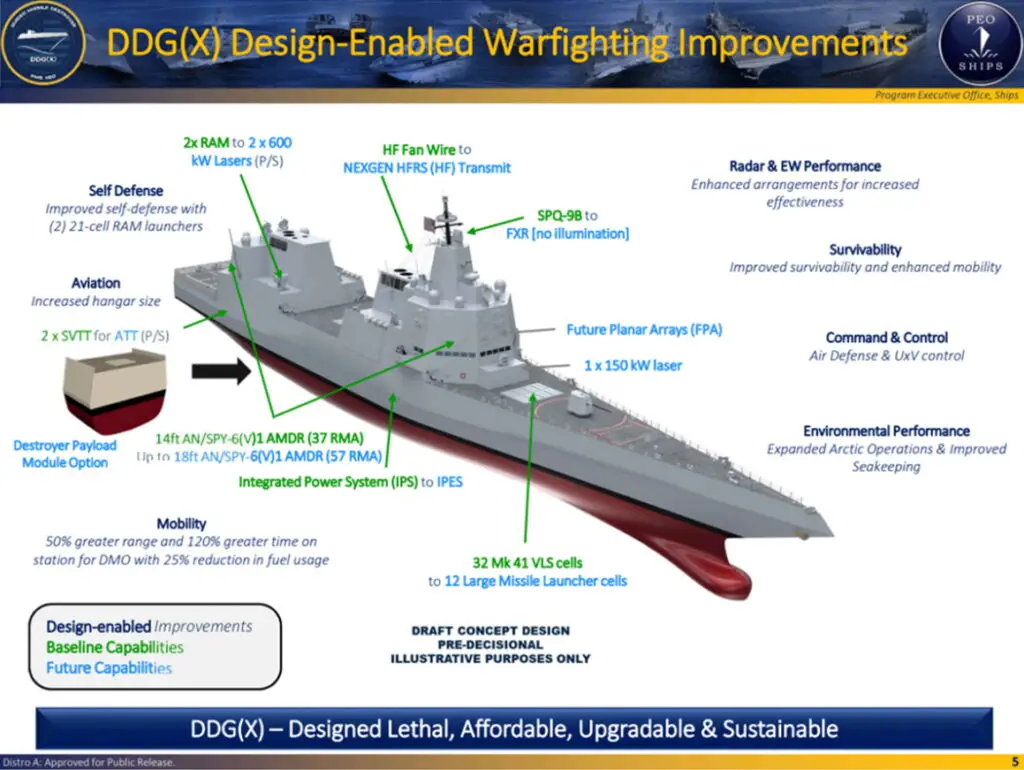According to a report on the website of the U.S. Naval Institute on the 12th, the U.S. Navy released the most detailed outlook for the next-generation main battleship DDG(X): it is equipped with hypersonic missiles and can fire laser weapons ten times more powerful than existing ones.
Developing and building a new destroyer to replace existing U.S. Navy ships has been discussed over the past few years. The Zumwalt project did not justify the expectations placed on it, so the USN plans to create a new ship of the same class, without the shortcomings of its predecessors. These discussions have resulted in tangible steps in the recent past, and now work is expected to start.
DDG (X)
The ship is expected to be one of the largest tonnage surface combat ships the U.S. Navy has attempted to build in more than 20 years, and it needs plenty of electrical power to power a new generation of directed-energy weapons and high-power sensors.
The Navy says the DDG(X) will integrate existing systems into the new hull design, which will provide platform versatility as well as the space, weight, power and cooling required to meet future combat capabilities, which is unattainable without the new hull design.
On DDG (X), the USN plans to use the latest combat system installed on the “Arleigh Burke” class destroyers, combining the newly developed SPY-6 active phased array radar and the “baseline 10” version of the Aegis system. The SPY-6 radar increases the antenna array area to improve the detection sensitivity, but the required power also doubles.

In addition, the U.S. plans to install laser weapons with a power of up to 600 kilowatts to intercept enemy missiles. To this end, DDG(X) will transplant the integrated power system used by the “Zumwalt” class destroyers, using gas turbines to drive high-power generators to meet the needs of the entire ship for electricity.
In the budget request for 2022, the Navy requested $ 121.8 million for the DDG (X) project for the “concept development, design analysis, test planning, ground testing and development of requirements for detailed design and construction of the main ship”.
The publication notes that although Ingalls Shipbuilding and Bath Iron Works may continue to build 3rd generation destroyers beyond 2027, the delay in the transition to DDG (X) will affect the Navy’s ability to use energy and hypersonic weapons in the surface fleet.
The U.S. Navy says the current-duty Arleigh Burke-class destroyers have exhausted their retrofit potential, leaving no room to install other new combat systems. The DDG(X) can be equipped with the same number of vertical launch cells as the “Arleigh Burke” class (96), but the bow 32-mounted vertical launch system can be replaced with 12 large launch cells to accommodate hypersonic missiles.
Navy officials believe that the DDG(X) will have a larger displacement than the DDG-51 Flight III, which has a displacement of 9700 tons, but less than the destroyers DDG-1000 (15700 tons). Presumably, the displacement of DDG (X) will be approximately 12,700 tons.
The DDG(X) destroyer will be versatile and provide the ability to quickly and affordably upgrade ship systems to more advanced ones when they reach the mass production stage, and will also have an increased cruising range and fuel efficiency to increase operational flexibility and reduce dependence on supply ships. DDG(X) will have an integrated power supply system that will provide the required level of power for weapons systems, sensors and computers. The cost of the ship is projected in the range of 3.5 – 4 billion dollars.
Next steps
The U.S. shipbuilders will now present their designs for the project. The U.S. Navy wants to evaluate several variants of the ship, from which they will choose the most successful one. In addition, the “combined” design method is not excluded. In this case, several competing organizations will present their projects, and the Navy will determine the most successful of their designs. These designs will be combined in the final design of the ship.
The finalisation of the design is targeted no later than 2028. The first order for construction of the ship is expected at the same time. The Navy wants to induct the lead destroyer in 2032, and the series will stretch at least until the forties. The total number of ships required has not yet been revealed.
